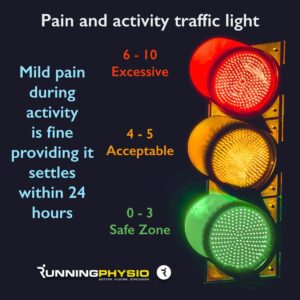POV:
You’ve been absolutely crushing your exercise routine for the last couple weeks and are starting to feel like you’re ‘back in shape.’ So what do you do? What else than to go hard in the paint and send it for a PR!
Ouch! The perfect concoction of excitement, ego, and maybe a little more than the ‘heaping’ scoop of your new pre-workout left you flared up, tweaked, or rendered ‘MIA’ in some capacity.
So, what are you going to do? Rest? Power through? Sulk your gains away?

We’ve been there. And honestly, we’ve tried all three options with little success in either direction. The process of painful training sucks; especially if you lack the experience of navigating the ups and downs of rehab. That’s why we’re here to help guide you through training with pain; a simple framework to help get you back to exercise safely and quickly.
Let’s dive in!
How Did This Even Happen??
Facing an injury or setback of any type will leave us questioning our training decisions and overzealous mindset before it all went awry. Constantly playing scenarios over and over again, we try and figure out how our name got stuck on the ‘injured list.’ While many will jump to blaming technique as the primary suspect, we’re here to respectfully challenge that idea.
Many of us have been pressured to perform exercises with an arbitrary ‘standard’ that somehow all body shapes and sizes must conform to, but why? We have very little data to propose that those ideas are accurate, and honestly, they even have a hard time holding up to the basics of biology.
Our bodies, in fact, are quite strong and capable of handling incredibly high loads, even in ‘disadvantaged’ positions (whatever that means). As a coach and clinician, I still address technique with some of my clients, however, it is almost always through the lens of ‘improving efficiency’ rather than ‘preventing injury.’
We, as humans, have been given the gift of adaptability. As biological beings, our bodiesare able to prepare themselves for the activities they encounter most frequently. So, if you’ve slowly graded the frequency and intensity of your encounters with ‘dAnGerOuS’ positions like spine flexion, it’s unlikely to be the reason you’re in pain.
‘Okay, well if it isn’t technique… then what is it?!’
We’re glad you asked! Like most things in fitness and rehab, there are likely multiple hands in the ‘injury’ cookie

jar. Putting on my ‘clinician cap,’ I tend to start simple:
- Was this a particularly demanding training week?
- Was it a load & rep scheme that you were comfortable with?
- What did life look like outside the gym (sleep, social stress, work/life balance, etc)?
- Did your training adequately prepare you to perform the activity you were injured with?
Chances are, changes in workload from training, or life stressors may have taken up a bigger piece of the pie than you may have realized, leaving you under-recovered, or otherwise under-prepared for today’s session.
If none of those sound familiar and you’re still scratching your head about how the heck you got so flared up, we would like to divert your attention to two of the truest words in the rehab and training worlds:
Shit Happens.
Sometimes it just doesn’t make sense, and that’s okay! We’ve got good news for you. Most gym & exercise-related injuries aren’t all that serious, and have a high likelihood of resolving on their own within days or weeks!
Looking to expedite the training & rehab process? Here are some ways we work with our own training clients to stay active in the midst of a flare up or injury.
Training & Pain: Lessons Learned
1. BUSINESS AS (UN)USUAL

So, you can’t squat to full depth at 90% of max weight, or can’t run at your normal pace for distance… Big whoop! Can you squat at 30%? What about doing a walk-run program? Whatever the variance is, there is likely an easy ‘entry point’ into performing the activities you want to do in a tolerable manner!
Better yet, often times modifying the activity that got you injured in the first place IS your rehab! After all, the best way to prepare for an activity is by doing that activity.
While we are often able to make big progress by just modifying a variable or two, sometimes training set-backs demand a little more attention. Cue lesson number two:
2. EXERCISE FOR PAIN ≠ EXERCISE FOR GAINS
If you wanted to start getting bigger biceps, what would you do? If the answer seems obvious, that’s because it is! It doesn’t take a Doctor or Personal Trainer to realize that progressively crushing curls to heavy metal will eventually add inches to your arms.

But that doesn’t mean training at high intensities and heavy loads is always the best when you’re in the midst of a flare up (for the record, heavy metal is optional at this stage). So, why is that?
When experiencing pain, sometimes all we need to do is expose the body to new positions and exercises that allow the system to ‘re-calibrate.’ Sure, 15 bicep curls with 10 pounds won’t do much to your sleeves if you crushed 4 sets of 12 with 35’s last week, but it may be enough to get your body to realize that curling is a safe activity!
Now, the question is, hammer curls, or supinated? What about rows? Could you get the same benefits if you did pull ups? Hmmm… Sounds like a whole new problem now.
3. THERE’S NO ‘BEST’ WAY TO GET BACK TO TRAINING
Ahhh yes, in a world of Do’s and Dont’s, sometimes it’s frustrating to hear advice that plants its flag in the middle. It’s true, we don’t have a single ‘best’ way to get back to exercising the way we want, but hopefully we can provide some structure to the amorphous advice of ‘do whatever you want.’
While rehab is anything but linear, we do know that we should be hitting some type of benchmarks associated with progress in order to know we’re on the right track. Those benchmarks are likely to look different depending on your goal activity, but often surround the idea of re-introducing tempo, range of motion, load, and/or total reps within a tolerable range of symptoms…
But wait… Notice how I said ‘tolerable range,’ instead of ‘pain free’? Yeah, read below to find out why.
4. ‘PAIN FREE’ MAY NOT BE A GOOD GOAL
We hate to say it, but constantly searching for movement to be ‘Pain Free’ just ain’t it. The reality is, we’re all likely to experience a bit of a twinge, ache, or pain every now and then, it’s part of trying to push ourselves to become better, faster, and stronger. Staying fearful of minor hiccups in an otherwise normal training session is likely to force unnecessary regressions in our exercise selection, leaving us to our own ‘de-training’ demise.
But how do you know when to keep pushing, or when to pull back? Don’t worry, we’re on it!
5. THE WINDOW OF OPPORTUNITY, THE STOP LIGHT, & THE ‘PROCESS’
Here’s a script that nearly every client in the last year has heard me say:
‘Having similar pain, soreness, or discomfort within 24-48 hours after exercise is totally normal. Even if the soreness goes beyond 2 days, I’m still not worried that anything bad is happening… I just want to make sure we can get enough exposure to these activities throughout the week, and they tend to suck more when you have lingering soreness & discomfort.’

Let’s add some nuance here. I don’t advise people to constantly search for painful activities and push their training habits into undue discomfort, but I want to make sure that we’re still making progress with the activities that we select. I often use the ‘Traffic Light’ analogy as a guide for people training with pain.
At the end of the day, the occasional training bite or pinch is totally normal and just another part of the process.
Final Thoughts
Trying to balance the seesaw of ‘rest’ and ‘expose’ when dealing with a training injury can be tough to manage. If you’re having a hard time with managing your training setbacks on your own, be sure to reach out to a qualified healthcare professional for more guidance. As always, this should not be interpreted as direct medical advice, each person responds differently and may require more specific treatment options as a part of their unique circumstances.
Thank you for reading! Looking for more awesome content to help your training & rehab plans? Be sure to check out our website, instagram, and subscribe to our emails!
Looking to work with us? Click here!


